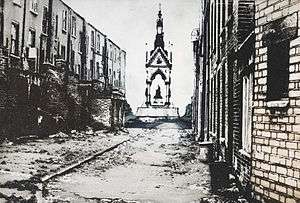Alyson Hunter

Alyson Hunter (born 1948) is a New Zealand photographer and print maker, resident in London, who, during the 1970s and 1980s, employed an unusual technique of etching with a chemically modified photographic image.[1]
Life
Alyson Hunter was born in Auckland, New Zealand, and is the twin sister of artist Alexis Hunter. She studied at Auckland University, then moving to London to study at Chelsea College of Art and the Royal College of Art.[2] With her husband, Hugh Stoneman, she was a director of Islington Studios and Islington Graphics Gallery.[2] In the 1980s, she travelled and lectured on print making, with Adrian Frost, in America, Australia and New Zealand, where her daughter Amy Frost was born in 1981. She was Master Printer at the New York Printmaking Workshop, and, in 1981 and 1983, University of California, Davis, Visiting Professor.[2] She lives with her daughter Amy, now a gallery manager, in North London.
Work
In 1971 she started making prints with an unusual technique that combined etching and photography, whereby a printing plate is created from a photograph and the plate worked on to alter the contrast, making use of the K.P.R. (Kodak Photo Resist) chemical: this is no longer available because of its toxicity.[1] Her print, For the Glory of the Empire, made using this process, juxtaposes two 19th-century architectural features, the Albert Memorial and the terraced house as contrasting features of the legacy of the British Empire.[1] She made a set of four prints, using this technique, of Camden Town, London, and its residents; one of these uses the background of Camden Lock behind a close-up of a gypsy boy.[3] These two works are in the Museum of London. Three landscape etchings 1972–72, including ones of Kent Road and Romney Marsh, were acquired for the British Government Art Collection.[4] She no longer used this photographic technique after 1987.[3]
In 1990, she moved away from printing into photography. Her portraits of photographers, Dan Farson and Harry Diamond, are in the collection of the National Portrait Gallery.[5]
Notes and references
- 1 2 3 "Photogravure using Kodak Photo Resist (KPR): For the glory of the Empire", Museum of London. Retrieved 29 January 2008.
- 1 2 3 "Alyson Hunter: short CV", alysonhunter.com. Retrieved 30 January 2008.
- 1 2 "Gypsy Boy, Camden Lock - print; photogravure using Kodak Photo Resist (KPR)", Museum of London. Retrieved 30 January 2008.
- ↑ "Government Art Collection", Department for Culture, Media and Sport. Retrieved 30 January 2008.
- ↑ "Alyson Hunter", National Portrait Gallery (London). Retrieved 30 January 2008.
External links
|